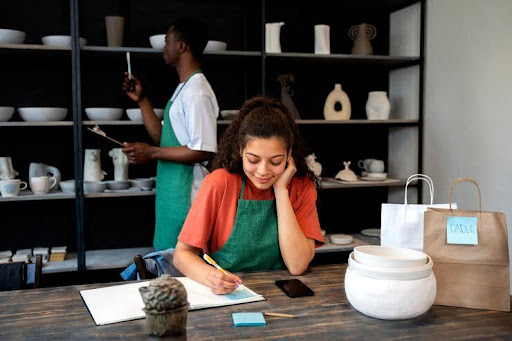Art at Your Fingertips: The Rise of Online Ceramics Lessons

In the digital age, access to education has undergone a transformative shift. With the advent of online learning platforms, individuals now have unprecedented opportunities to explore and master a myriad of subjects from the comfort of their own homes. Among these subjects, ceramics—an ancient art form dating back thousands of years—has found a new medium through which to flourish: online ceramics lessons.
The Evolution of Ceramics Education
Historical Context: Ceramics, encompassing pottery, sculpture, and other forms of clay-based art, has a rich history spanning civilizations and cultures worldwide. From ancient Mesopotamia to modern-day studios, ceramics has been a constant presence in human artistic expression.
Traditional Learning Methods: In the past, learning ceramics often involved attending in-person classes or workshops conducted by experienced artists and instructors. While these methods were effective, they were often limited by factors such as geographical location and scheduling conflicts.
Democratization of Access: The rise of online ceramics lessons has democratized access to this age-old craft, breaking down geographical barriers and expanding opportunities for learning. Now, individuals from all walks of life can access high-quality ceramics instruction regardless of their location or background.
Advantages of Online Ceramics Lessons
Flexibility and Convenience
Self-Paced Learning: Ceramics class offer self-paced learning, allowing students to progress through the material at their own speed. This flexibility is particularly beneficial for individuals with busy schedules or irregular work hours.
24/7 Accessibility: Unlike traditional classes that adhere to a fixed schedule, online ceramics lessons are available round-the-clock. Whether it’s early morning or late at night, students can access course materials whenever it’s most convenient for them.
Diverse Instructional Resources
Wide Range of Courses: Online ceramics platforms offer a diverse range of courses catering to various skill levels and interests. From beginner-level introductions to advanced masterclasses, there’s something for everyone, regardless of their experience level.
Global Perspectives: Through online ceramics lessons, learners have the opportunity to explore diverse styles and approaches from instructors worldwide. This exposure to different artistic traditions enriches their understanding of ceramics and inspires new creative possibilities.
Interactive Learning Experience
Virtual Demonstrations: Many online ceramics lessons incorporate virtual demonstrations, allowing students to observe techniques in real-time. This hands-on approach enhances comprehension and retention, enabling learners to grasp complex concepts more effectively.
Live Q&A Sessions: Interactive elements such as live Q&A sessions and community forums foster engagement and provide opportunities for students to seek guidance and feedback. This direct interaction with instructors and peers facilitates deeper learning and skill development.
Cost-Effectiveness
Elimination of Commuting Costs: With no need to commute to physical studios, learners can save on transportation expenses. This cost-saving benefit makes online ceramics lessons more accessible to individuals with limited financial resources.
Affordable Pricing Models: Many online platforms offer subscription-based models or one-time course purchases at affordable rates. This pricing flexibility allows students to access high-quality instruction without breaking the bank, democratizing ceramics education further.
Overcoming Challenges
Lack of Hands-On Guidance
Supplemental Resources: To address the absence of hands-on guidance, some online platforms incorporate virtual studio visits or personalized coaching sessions. These supplemental resources provide additional support and guidance to students as they navigate the learning process.
Practical Exercises: Interactive assignments and practical exercises help reinforce learning and provide opportunities for hands-on practice. While students may not have direct supervision, these activities allow them to apply theoretical knowledge in a practical context and refine their skills.
Equipment and Materials Accessibility
Alternative Techniques: Online ceramics courses may offer alternative techniques or suggestions for makeshift studio setups using readily available materials. By exploring creative solutions, instructors empower students to overcome limitations and adapt their practice to their circumstances.
Local Resources: Some platforms provide recommendations for local suppliers or community studios where students can access equipment and materials. This support network connects learners with resources in their area, facilitating greater access to the tools needed for ceramics practice.
Limited Social Interaction
Virtual Communities: Online ceramics platforms foster virtual communities where participants can connect with instructors and peers, share insights, and collaborate on projects. These digital communities provide a sense of belonging and support, compensating for the lack of in-person interaction.
Live Events: Virtual workshops, exhibitions, and collaborative projects provide opportunities for students to interact with each other and engage in collective learning experiences. While physical distance may separate learners, these live events create opportunities for meaningful connection and collaboration.
The Future of Online Ceramics Education
Technological Innovations: Advancements in technology, such as virtual reality (VR) simulations and augmented reality (AR) applications, may revolutionize how students engage with ceramics. These immersive technologies offer new avenues for exploration and experimentation, blurring the lines between physical and digital learning environments.
Global Collaboration: The global reach of online ceramics platforms presents opportunities for cultural exchange and cross-disciplinary collaboration. Artists from different backgrounds and traditions can come together to share knowledge, techniques, and perspectives, enriching the creative landscape and fostering mutual understanding.
Embracing Creativity and Community
Cultural Enrichment: Online ceramics education fosters a culture of creativity and community, where learners from diverse backgrounds come together to share knowledge, experiences, and perspectives. This cultural exchange enriches the learning experience and broadens students’ understanding of ceramics as a global art form.
Empowerment Through Art: By leveraging technology to overcome traditional barriers, online ceramics platforms empower individuals to unleash their creativity and pursue their passion for ceramics on their own terms. Whether they’re beginners or seasoned artists, students have the tools and resources they need to explore their artistic potential and express themselves through clay.
Conclusion
In conclusion, the rise of online ceramics lessons represents a paradigm shift in how we approach arts education. As technology continues to advance and online learning becomes increasingly accessible, the world of ceramics stands poised for a renaissance, with endless opportunities awaiting those willing to explore it.



